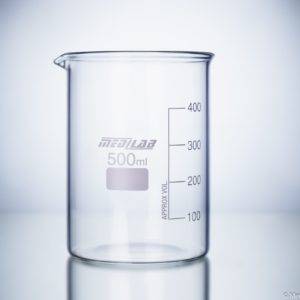Description
| Catalog No. | Nominal capacity ml | Socket Size |
| 11149/1 | 100 | 24/29 |
| 11149/2 | 250 | 29/32 |
| 11149/3 | 500 | 29/32 |
| 11149/4 | 1000 | 29/32 |
| 11149/5 | 2000 | 29/32 |
The MEDILAB Flask Evaporating is a specialised laboratory glass vessel designed for efficient evaporation, concentration, and distillation of solutions under controlled conditions. Its wide, uniform surface area ensures rapid heat transfer and optimised solvent removal. Essential in research, analytical, and industrial laboratories, this flask provides excellent visibility, chemical durability, and thermal stability during heating or vacuum operations. Ideal for pharma, chemical, biotech, and academic workflows, it delivers reliable performance in routine and high-precision evaporation processes.
Key Features
- Manufactured from premium Borosilicate Glass 3.3 for superior thermal and chemical resistance.
- Uniform wall thickness ensures safe heating and consistent evaporation performance.
- Optimised geometry for maximum surface area contact with heating media.
- Smooth and clear glass finish for easy monitoring of contents.
- Resistant to thermal shock, acids, alkalis, and organic solvents.
- Suitable for vacuum applications (as per capacity and conditions).
- Autoclavable and reusable for long-term laboratory use.
- Available in a wide range of capacities for general and high-volume evaporation needs.
Material Specifications
- Material: Borosilicate Glass 3.3
- Thermal Properties: High resistance to thermal shock (ΔT up to 150°C) Low coefficient of thermal expansion: 3.3 × 10⁻⁶ /°C
- Chemical Resistance: Excellent resistance to most acids, alkalis, and organic solvents. Non-reactive, ideal for sensitive chemical processes
- Mechanical Properties: High mechanical strength and durability. Smooth surface reduces contamination risks
- Compliance Standards: Manufactured as per international laboratory glassware standards.
Technical Specifications
- Available Capacities: As per the standard size table
- Dimensions: Diameter, height, and neck size vary as per capacity (custom size chart available).
- Tolerance: Standard laboratory tolerance; precise wall thickness for safe heating applications.
- Calibration: Not typically calibrated; used primarily for evaporation, concentration, and solvent removal.
- Accessories (optional): Rubber or PTFE stoppers Joint adapters for rotary evaporators Support clamps and stands
Handling & Precautions
- Safe Use: Heat gradually to avoid thermal shock. Use with appropriate support stands and clamps during heating or vacuum operations.
- Cleaning Instructions: Clean with mild detergents; avoid abrasive pads. Compatible with standard lab glass cleaners and ultrasonic baths.
- Autoclaving / Heat Limits: Safe for dry heat and steam sterilisation. Do not exceed the maximum operating temperatures recommended for borosilicate glass.
- Do’s & Don’ts: Do: Inspect glass for cracks before use. Do: Ensure even heating for the best evaporation efficiency. Don’t: Expose the flask to sudden temperature changes. Don’t: Use over an open flame unless designed for flame heating.
- Best Practices: Allow gradual cooling after heating. Store in padded racks to prevent mechanical damage.
Applications
- Pharmaceutical & Chemical R&D: Solvent evaporation, concentration of samples, reaction monitoring.
- Biotechnology & Life Science Labs: Preparation of extracts, removal of moisture, and sample refining.
- Academic & Research Institutions: Teaching labs, analytical procedures, distillation setups.
- Quality Control / Quality Assurance Labs: Concentration before analysis, residue determination.
- Industrial Laboratories: Evaporating solvents during production and formulation development.
Integral to daily laboratory workflows, the evaporating flask is widely used with heating mantles, water/oil baths, and rotary evaporators.







